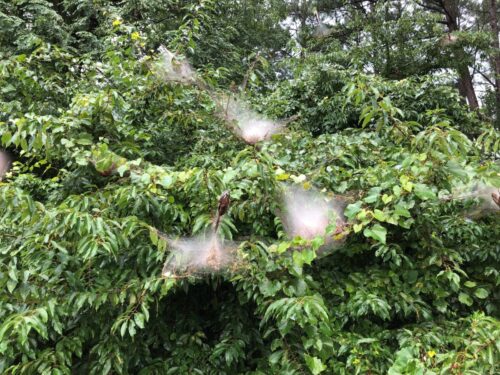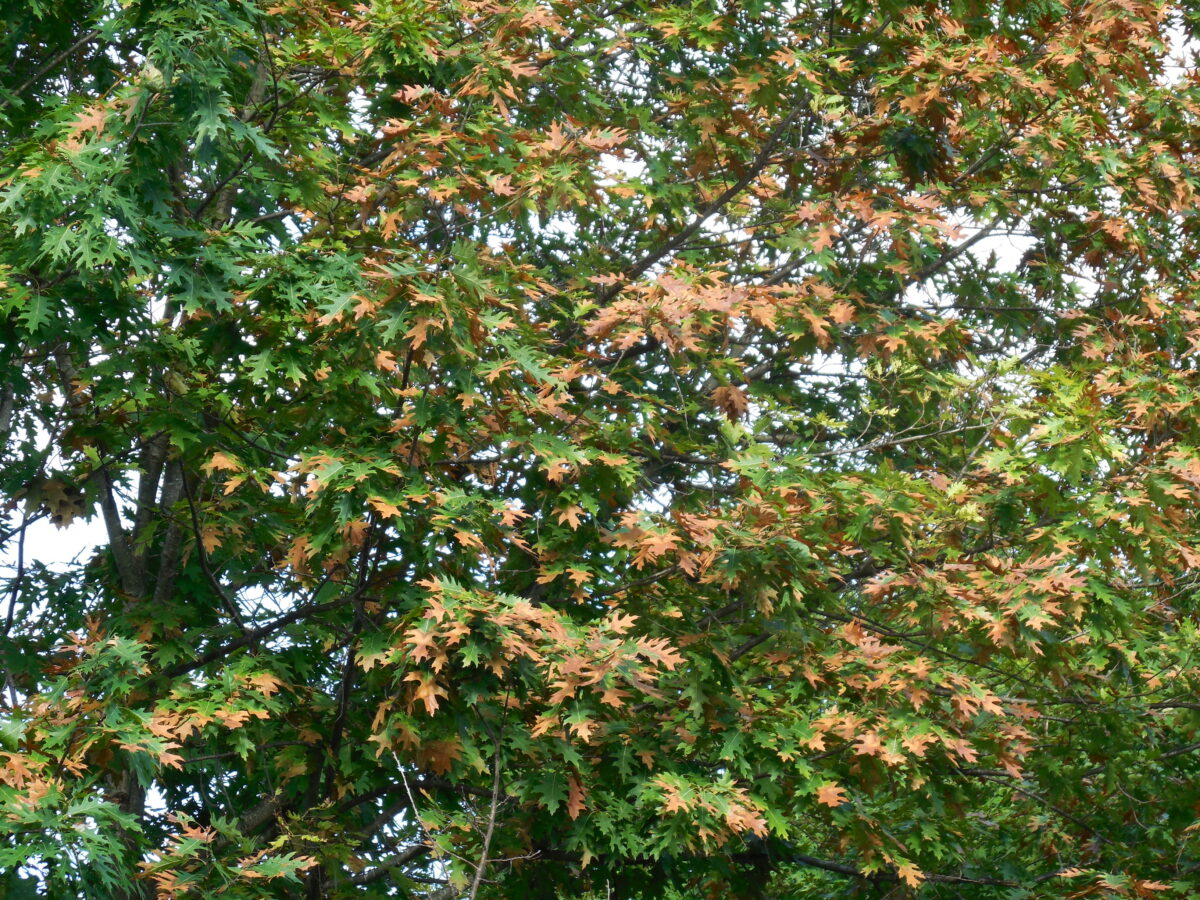Don’t Judge a Tree by Its Color
August 25, 2022 12:10 pm

A Brief Guide to Late Summer Tree Pests
By Amanda Conrad, DOF Forest Health Technician
As the summer heat fades and autumn looms right around the corner, you may notice some changes to leaves that have nothing to do with the seasons. Late summer provides a unique setting for forest and tree pests that go mostly unnoticed until this time of year.
One such pest, the fall webworm (Hyphantria cunea), is somewhat misnamed. These native insects are most noticeable in late summer, when they cover the ends of tree branches with dense silk webs. Fall webworms have no strong preference when it comes to host trees; you can find them on over 100 hardwood tree species from southern Canada to Northern Mexico. Webworm larvae hatch in early summer to feed on leaves and spin silk. They eventually produce enough silk to cover entire branches, making a tent in which they can feed and develop. The larvae will develop in these silk tents until early fall, when they reach full size and emerge to seek pupation sites to overwinter.
- It’s a prolific year for fall webworm in central Virginia!
- Caterpillar close-up; photo credit Penn. Dept. of Conservation & Natural Resources – Forestry, bugwood.org
The webworm’s silk tents might be unsightly, but rarely do they cause major damage to trees. The larvae feed on leaves at the end of the season when trees have gathered most of their energy and are preparing for winter. Population control is usually not necessary, as these pests are native and have natural enemies that use them as a food source, including migrating warblers, vireos and other songbirds who rely on insects such as webworms as an energy source on their great journey southward.
Much like the fall webworm, the locust leafminer (Odontota dorsalis) can cause quite a stir in late summer. This native beetle can have two generations a year, either surviving through the winter or hatching from eggs and reaching adulthood by July. True to their name, the developing leafminer larvae feed by chewing tunnels between leaf layers, most often on black locust trees. This feeding can lead to clusters of trees that appear prematurely brown, dry, or dead in late summer. Besides black locust, leafminers also will feed on honeylocust, apple, beech, birch, cherry, elm, oak, and hawthorn trees.
- Locust leafminer adult; photo credit David Cappaert, bugwood.org
- Foliage browning of black locust as a result of larval feeding; photo credit Chris Evans, Univ. of Illinois, bugwood.org
Like the webworm, the leafminer’s effect might seem visually extreme but rarely causes major damage to the tree overall. Again, natural enemies exist to help control populations, so control methods are generally not warranted. To help keep trees healthy and combat lasting damage by the webworm and leafminer, provide trees with adequate water during the summer months.
A third – and more serious – late-season pest is the bacterium Xylella fastidiosa, the causal agent of bacterial leaf scorch. This tree disease disrupts the water transportation system, or xylem, of a tree. This disruption means that water can no longer reach the edges of leaves, leaving them with a brown or scorched appearance. As the disease progresses, browning will progress from the tips of leaves to the base. The bacteria have been found to affect oak, elm, sycamore, red maple, and several other tree species. Symptoms typically appear in late summer and are often mistaken for drought. Depending on the type of tree, bacterial leaf scorch can present itself in different ways, but the most common symptom is a yellow border separating dead from living leaf tissue. Trees will first show symptoms on inner lower branches, moving out and up the tree over time.
- Bacterial leaf scorch symptoms over a large portion of this oak tree
- Typical leaf symptoms; photo credit John Hartman, Univ. of Kentucky, bugwood.org
This disease progresses slowly, but it will kill a tree over a period of years. The bacteria are often spread by insects, such as leafhoppers, and through poor sanitation practices when pruning. Bacterial leaf scorch unfortunately has no known cure, but the symptoms can be alleviated on a yearly basis through antibiotic tree injection.
The next time you see a tree that looks out of place in the late summer heat, remember that there could be a tree pest at work. Or perhaps it’s just a reminder that fall is right around the bend!
Tags: Forest Health Impacts, Insects, Tree Health
Category: Forest Health






